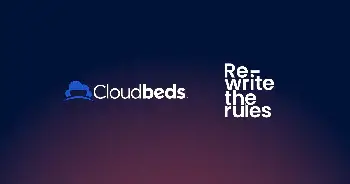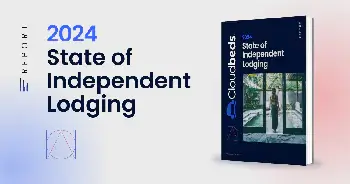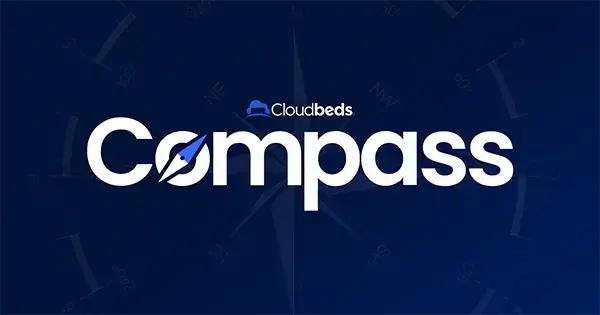A quick guide to hotel profit
margins for aspiring owners
One of the biggest challenges of owning a property is turning a consistent profit. Lodging businesses are cost-intensive to own and operate, with high labor costs and high guest expectations of service, quality, and amenities. At the same time, revenue streams can be volatile and unpredictable.
To maintain profitability over time and reduce unnecessary stress, hotel owners must always keep an eye on the bottom line. But how exactly is profit measured, and what are the key drivers of profitability in the hospitality industry? Here we share the terms and metrics every hotel owner needs to know, along with eight ways to improve profitability.
What is a hotel’s profit margin?
A simple definition of profit is the money a property has left over after it has collected its revenue and paid its expenses. However, this money doesn’t necessarily go into the owner’s pocket. There’s a difference between gross operating profit, a measure of a property’s operating revenue less operating costs, and net profit, a measure of all revenue less all expenses, including interest and taxes. Net profit is considered the real “bottom line.”
A hotel’s profit margin is reported in its profit & loss (P&L) statement, also called income statement, which is produced each month and for the entire fiscal year. In the P&L, the hotel’s revenue, expenses, and profits (or losses) are itemized overall and by department. The P&L also reports non-operating activities and the hotel’s net profit.
Generally, owners, operators, and management companies follow the guidelines in the Uniformed System of Accounts for the Lodging Industry (USALI), a standardized accounting system designed to establish uniformity in the hotel industry’s financial reporting and accounting practices.
How is profit margin calculated?
Whereas profit is reported as an absolute number, profitability or profit margin is reported as a percentage. Generally, the higher the profit margin, the better the property’s financial performance and operational efficiency.
The formula for calculating gross operating profit (GOP) for a given period, such as a month or year, is as follows:
Gross Operating Profit (GOP) = Total Revenue – Total Operating Costs
And here’s the formula for calculating the gross margin:
Gross Profit Margin = (Gross Operating Profit / Total Revenue) x 100
For example, if a hotel takes in $78,500 in revenue in November and has $67,300 in expenses, its gross operating profit for the month is $11,200, and its gross profit margin is 14.3%.
Important profitability metrics
In addition to GOP and profit margin, various other key performance indicators (KPIs) are used to measure hotel revenue growth and profitability.
For your hotel business, it’s important to track, analyze, and benchmark these metrics on a regular basis. These numbers signal whether or not the property is achieving its financial goals, areas where the property is underperforming, and the changes needed to get back on the road to profitability.
These days, with inflation and staffing shortages driving up operating expenses, monitoring these metrics is especially crucial for controlling expenditures and ensuring that costs don’t exceed revenues.
A few of the most important metrics include:
Total Revenue per Available Room (TrevPAR)
While revenue per available room (RevPAR) is a good metric for tracking room revenue, total revenue per available room (TrevPAR) takes things a step further by measuring total revenue and dividing it by the number of available rooms in a hotel. Total revenue may include rooms, food & beverage, spa, or parking, depending on the property’s offerings.
The formula for calculating TrevPAR is as follows:
Total Revenue per Available Room (TrevPAR) = Total Revenue / Total Available Room Nights
Gross Operating Profit per Available Room (GOPPAR)
To capture a more complete picture of financial performance, gross operating profit per available room (GOPPAR) considers both total revenue and total operating costs, measuring the average profitability generated for each available room in a hotel.
The formula for calculating GOPPAR is as follows:
Gross Operating Profit per Available Room (GOPPAR) = Gross Operating Profit / Total Available Room Nights
Labor Cost per Available Room (LPAR)
Labor is typically the highest operating expenditure for hotels, representing 49% of total costs on average, according to STR. Labor cost per available room, or LPAR, helps hoteliers understand and control labor costs by measuring labor expenses relative to the number of available rooms in the hotel.
The formula for calculating LPAR is as follows:
Labor Cost per Available Room (LPAR) = Total Labor Costs / Total Available Room Nights
Guest Acquisition Cost (GAC)
Guest acquisition cost (GAC) is a measure of the expenses used to generate bookings for a hotel relative to the room revenue generated. This includes sales & marketing expenses, online travel agency (OTA) commissions, booking transaction fees, and other related costs. Generally, the lower the guest acquisition cost, the more profitable room sales are.
The formula for calculating GAC is as follows:
Guest Acquisition Cost (GAC) = (Total Acquisition Costs / Total Rooms Revenue) x 100
What is the average profit margin?
Typical profit margins vary widely by property, depending on its location, size, type or category, amenities, pricing, competition, operating efficiency, and other factors. While there isn’t a lot of data about average hotel profit margins available publicly, here are some relevant statistics.
- In the first 10 months of 2022, the average gross operating profit for U.S. hotels was 38%, compared to 39% in 2019.
- In 2022, U.S. hotel revenues and profits achieved an all-time high, but so did labor costs, with an average GOPPAR of $73.70, TrevPAR of $202.23, and LPAR of $65.94
- Profit margins can vary broadly by department. For example, while the room division operates at an average GOP margin of about 75%, the F&B department’s GOP margin is closer to 25%.
Hotel revenue sources
Revenue sources may vary according to the type of hotel, but they can generally be divided into three main categories:
- Revenue from guestroom sales
- Revenue from food and beverage sales, including:
- Outlets such as the restaurant, bar, café, and food bar
- Meetings and events
- Room service
- Minibar
- Revenue from other sources, including:
- Function space & equipment rentals
- Internet fees
- Resort fees
- Parking
- Spa
- Recreation
Hotel costs
A hotel’s expenses can be divided into fixed costs and variable costs. Fixed costs generally remain the same regardless of how busy the property is, although they may change periodically. Variable costs can fluctuate from day to day and are often correlated with occupancy rates.
Examples of fixed costs:
- Payroll-related expenses
- Real estate fees (rent or mortgage)
- Property taxes
- Insurance
- Fixed monthly bills like cable and internet
- Franchise and hotel management fees
- Technology (E.g., fixed monthly subscription fees)
Examples of variable costs:
- Hourly labor
- Utilities like gas, electricity, and water
- Marketing and distribution
- Housekeeping supplies
- Maintenance costs
- Food and beverage inventory
- Credit card commissions and other payment processing fees
- Technology (if fees are charged on a per-usage basis)
8 ways hotels can improve profitability
For aspiring hotel owners, the time to start thinking about profitability is now. Here are some key strategies hotels can follow to improve the bottom line.
1. Practice revenue management
For most hotels, rooms are the biggest source of revenue. To strike the optimal balance between high average occupancy and high average daily rates (ADR), hotels must practice revenue management, the process of optimizing pricing strategies, inventory, and distribution to maximize net profit margin.
Marco Leibundgut, Founder of the Bogentrakt Hostel in Chur, Switzerland, tested the impact of revenue management in his first few months of business. He decided not to use PIE, Cloudbeds’ Pricing Intelligence Engine, in the first month of operations and instead used their lowest price to see how many bookings they could get. The next month, he set up rules in PIE and “saw a huge growth in revenue.”
2. Uphold high standards of quality and service
While delivering high standards of quality and service requires investments in staff training, quality amenities, and property upgrades, it will help ensure guests are happy, loyal, and eager to spread the word. This in turn will attract more bookings and more revenue.
Deliver high standards of quality and service every time with Standard Operating Procedures (SOPs).
3. Manage costs by department
Because profit margins vary by department, it’s important to scrutinize monthly P&Ls to understand revenue and costs in each area and how they contribute to overall profitability. Use the insights to find areas to improve performance, whether it’s creating packages to boost breakfast sales or purchasing a new boiler to reduce energy consumption.
4. Boost ancillary revenue
For some hotels, non-rooms revenue represents a significant portion of total revenue. This may include sales from the restaurant and bar, meetings & events, room service, spa, recreation, and upsells. By bundling these services into packages and promoting them via guest messaging (email, SMS, WhatsApp, social media), properties can increase average spend and boost profitability.
5. Focus on variable expenses
Reducing variable costs like utilities, F&B inventory, and housekeeping supplies is often a quick way to boost profitability. Calculate cost per occupied room (CPOR) to understand the relationship between costs and occupancy. Look for opportunities for greater economies of scale and ensure that when occupancy goes down, consumption in these areas go down, too.
6. Control operating costs
As important as generating revenue is reigning in operating costs. Of the revenue coming in, how much is going to expenses, and how much is flowing through to the bottom line? Finding efficiencies in everything from staff scheduling to laundry costs can significantly impact profitability.
Michael Kelley, Owner of The South Wind Motel in Columbus, Ohio, knew when starting his business that they wouldn’t be able to economically staff the property 24/7. He decided to use technology to handle guest communication remotely so that he doesn’t need staff onsite after 8 pm. Instead, guests can check in with personalized codes and reach out to staff via text if they have any questions.
7. Reduce guest acquisition costs
Guest acquisition costs (GAC) can vary significantly by channel. For example, the costs associated with direct reservations are typically low, whereas the costs of online travel agencies (OTA) bookings are relatively high. By measuring GAC by distribution channel, hoteliers can aim for the channel mix that brings the highest overall returns on investment.
Repeat guests are also cheaper than new guests. To attract returning travelers, consider implementing loyalty programs and other initiatives, such as discounts and referral incentives.
8. Invest in technology
Investing in the right technology can work wonders for profit margins by amplifying the hotel’s reach, automating tasks, and providing easy access to valuable insights about guest preferences and behavior.
Look for a robust hospitality solution that offers tools such as:
- Revenue management software to help position room rates competitively and optimize the performance of room inventory by finding the ideal balance between occupancy and average rate.
- A channel manager to increase revenue by reaching more travelers on more booking channels and maintaining a diverse distribution mix.
- A website booking engine to attract more bookings at lower guest acquisition costs by making it easy for travelers to book a room directly on the hotel website.
- A property management system (PMS) to help manage operations more efficiently and provide a higher level of guest service by automating various tasks and maintaining a rich database of guest profiles.
- Self-check-in and keyless entry software to increase efficiency and reduce labor costs by giving guests the option to check themselves in online and enter the room using a digital code or mobile phone.
- A payment system to attract more bookings and improve the guest experience by simplifying and automating payment processing.
Last but not least, we can’t overlook the vital role employees can play in driving hotel profitability. By sharing financial objectives and rewarding staff for achieving them, hotel owners can cultivate a company culture that prizes profitability, teamwork, and guest satisfaction.


















